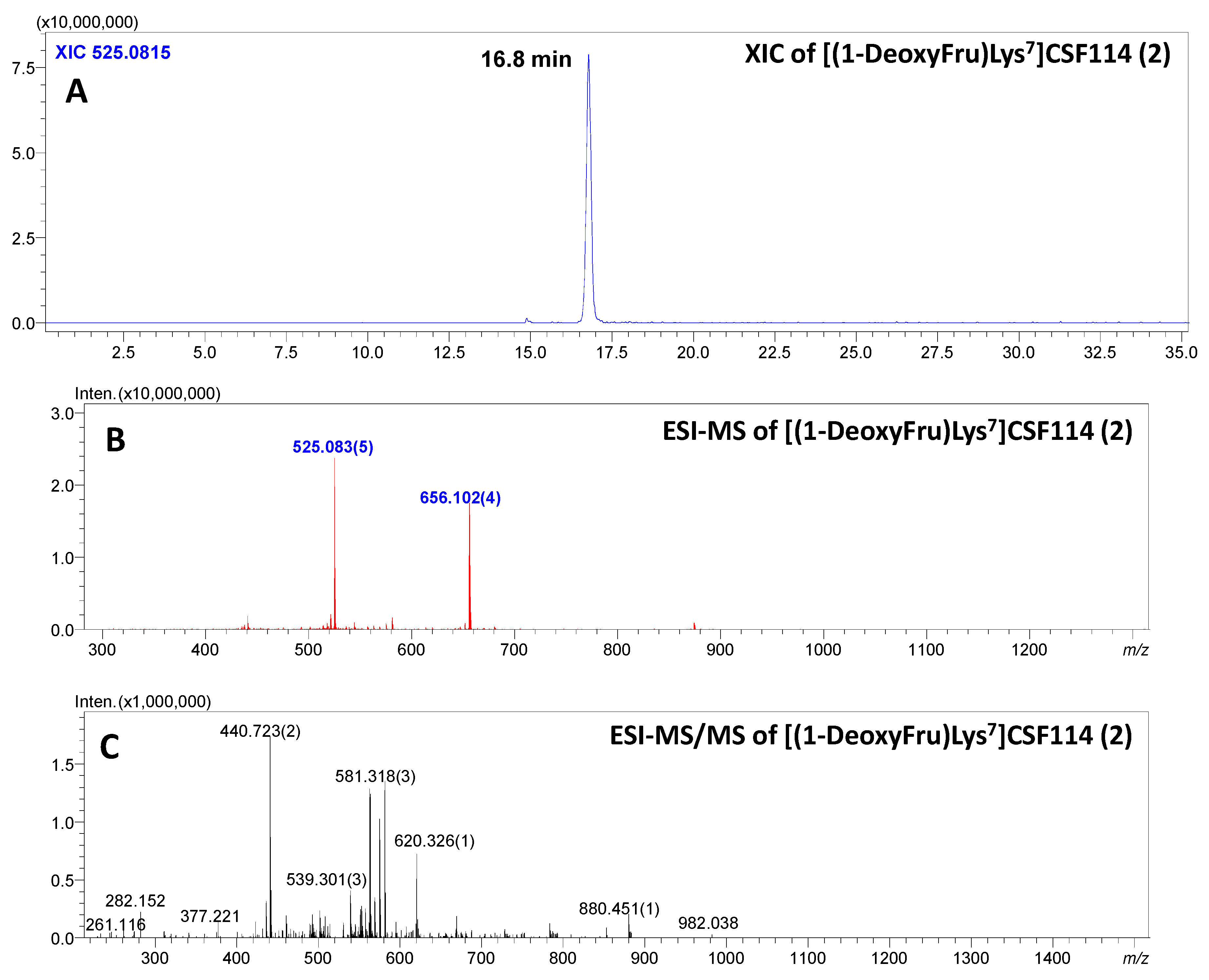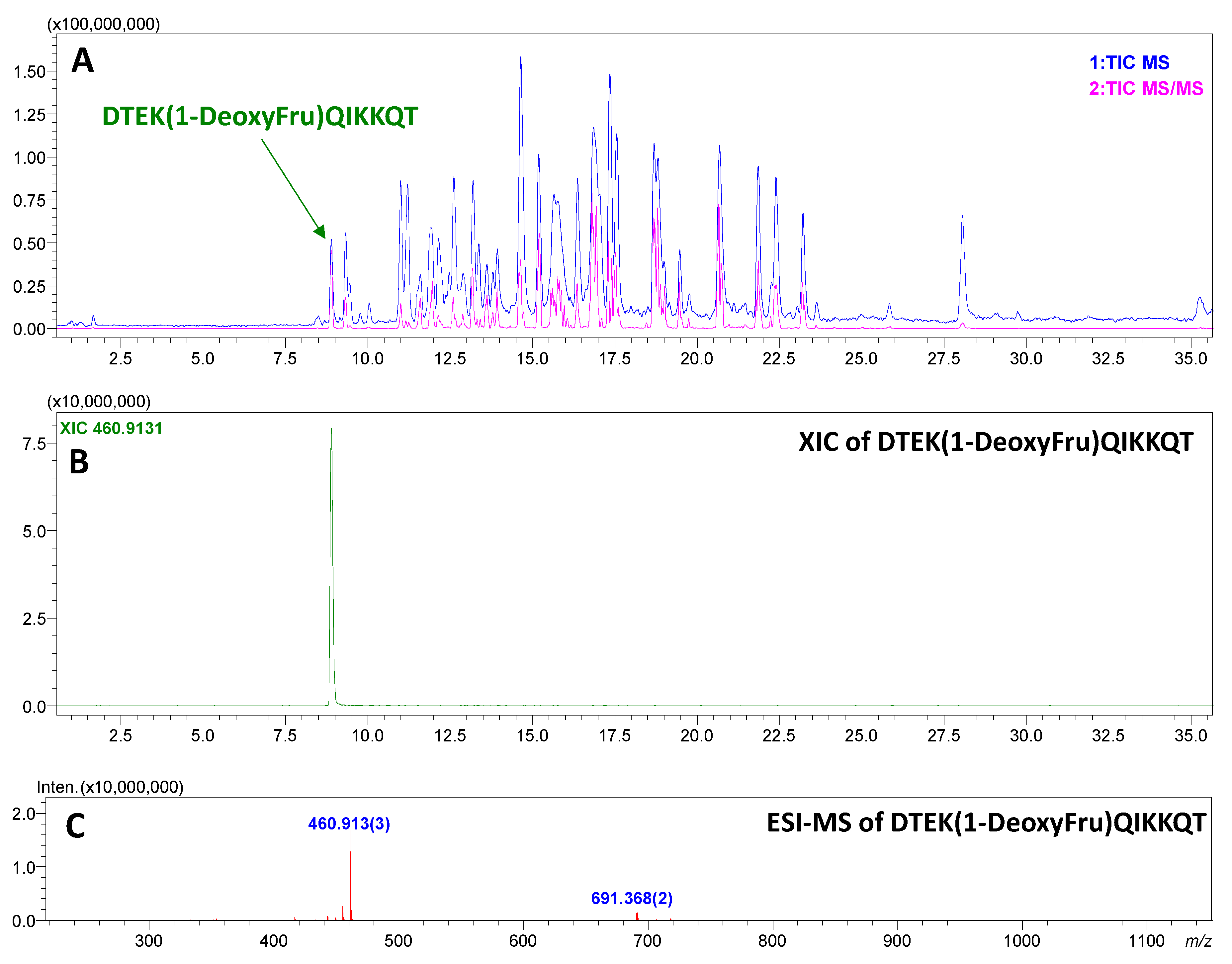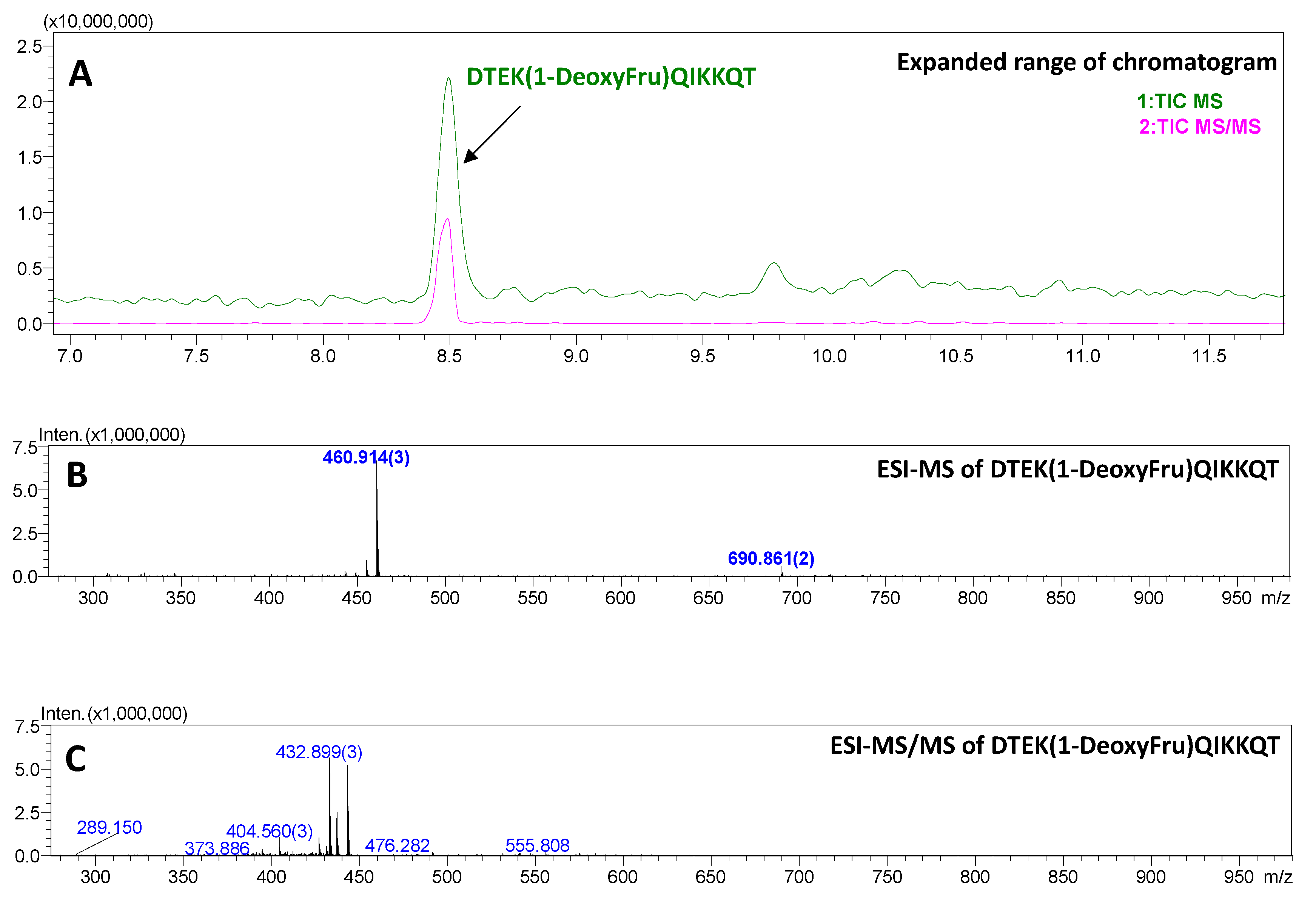An Optimised Di-Boronate-ChemMatrix Affinity Chromatography to Trap Deoxyfructosylated Peptides as Biomarkers of Glycation
Abstract
:1. Introduction
2. Materials and Methods
2.1. Synthesis of the PhB-Lys(PhB)-ChemMatrix® Rink Resin
2.2. General Capturing Protocol of Model Deoxyfructosylated Peptide 1
2.3. Capturing Conditions of Peptides 2–8
2.4. Capturing Conditions of Peptide 2 in the Mixture of Peptides 7 and 9–17
2.5. Capturing Conditions of Peptide 2 and 18 in HSA or BSA Hydrolysate
2.6. Bioinformatic Analysis with PEAKS
3. Results and Discussion
3.1. Development of a Specific ChemMatrix® Rink Resin Functionalised to Selectively Capture Deoxyfructosylated Peptides
3.2. The PhB-Lys(PhB)-ChemMatrix® Rink Resin Is Specific for Deoxyfructosylated Peptides and Not for Differently Glycosylated Peptides
3.3. The PhB-Lys(PhB)-ChemMatrix® Rink Resin Is Specific for Deoxyfructosylated Peptides and Not for Unrelated Non-Glycosylated Peptides
3.4. The PhB-Lys(PhB)-ChemMatrix® Rink Resin Is Also Specific for Deoxyfructosylated Peptides in Complex Peptide Mixtures (i.e., Human Serum Albumin and Bovine Serum Albumin Hydrolysates)
4. Conclusions
Supplementary Materials
Author Contributions
Funding
Acknowledgments
Conflicts of Interest
References
- Thornalley, P.J. Dicarbonyl intermediates in the Maillard reaction. Ann. N. Y. Acad. Sci. 2005, 1043, 111–117. [Google Scholar] [CrossRef]
- Ahmed, N.; Thornalley, P.J. Advanced glycation endproducts: What is their relevance to diabetic complications? Diabetes Obes. Metab. 2007, 9, 233–245. [Google Scholar] [CrossRef] [PubMed]
- D’Aronco, S.; Crotti, S.; Agostini, M.; Traldi, P.; Chilelli, N.C.; Lapolla, A. The role of mass spectrometry in studies of glycation processes and diabetes management. Mass Spectrom. Rev. 2019, 38, 112–146. [Google Scholar] [CrossRef] [PubMed] [Green Version]
- Dell, A.; Morris, H.R. Glycoprotein structure determination by mass spectrometry. Science 2001, 291, 2351–2356. [Google Scholar] [CrossRef] [PubMed]
- Feng, S.; Yang, N.; Pennathur, S.; Goodison, S.; Lubman, M. Enrichment of glycoproteins using nano-scale chelating Con A monolithic capillary chromatography. Anal. Chem. 2009, 81, 3776–3783. [Google Scholar] [CrossRef] [PubMed] [Green Version]
- Frolov, A.; Blüher, M.; Hoffmann, R. Glycation sites of human plasma proteins are affected to different extents by hyperglycemic conditions in type 2 diabetes mellitus. Anal. Bioanal. Chem. 2014, 406, 5755–5763. [Google Scholar] [CrossRef] [PubMed]
- Soboleva, A.; Modzel, M.; Didio, A.; Płóciennik, H.; Kijewska, M.; Grischina, T.; Karonova, T.; Bilova, T.; Stefanov, V.; Stefanowicz, P.; et al. Quantification of prospective type 2 diabetes mellitus biomarkers by stable isotope dilution with bi-labeled standard glycated peptides. Anal. Methods 2017, 9, 409–418. [Google Scholar] [CrossRef]
- Domínguez, H.; Sánchez-Ferrer, C.F. The role of glycated proteins on cardiovascular diabetic complications: New findings. J. Am. Coll. Cardiol. 2017, 70, 2020–2021. [Google Scholar] [CrossRef]
- Liu, Z.; He, H. Synthesis and applications of boronate affinity materials: From class selectivity to biomimetic specificity. Acc. Chem. Res. 2017, 50, 2185–2193. [Google Scholar] [CrossRef] [Green Version]
- Kumai, M.; Kozuka, S.; Samizo, M.; Hashimoto, T.; Suzuki, I.; Hayashita, T. Glucose recognition by a supramolecular complex of boronic acid fluorophore with boronic acid-modified cyclodextrin in water. Anal. Sci. 2012, 28, 121–126. [Google Scholar] [CrossRef] [Green Version]
- Kijewska, M.; Kluczyk, A.; Stefanowicz, P.; Szewczuk, Z. Electrospray ionization mass spectrometric analysis of complexes between peptide-derived Amadori products and borate ions. Rapid Commun. Mass Spec. 2009, 23, 4038–4046. [Google Scholar] [CrossRef] [PubMed]
- Liu, X.C.; Scouten, W.H. Boronate Affinity Chromatography. In Affinity Chromatography; Bailon, P., Ehrlich, G.K., Fung, W.J., Berthold, W., Eds.; Methods in Molecular Biology; Humana Press: Totowa, NJ, USA, 2000; Volume 147. [Google Scholar]
- Ren, L.; Liu, Z.; Dong, M.; Ye, M.; Zou, H. Synthesis and characterization of a new boronate affinity monolithic capillary for specific capture of cis-diol-containing compounds. J. Chromatogr. A 2009, 1216, 4768–4774. [Google Scholar] [CrossRef] [PubMed]
- Xue, X.; Zhao, Y.; Zhang, X.; Zhang, C.; Kumar, A.; Zhang, X.; Zou, G.; Wang, P.C.; Zhang, J.; Liang, X.-J. Phenylboronic acid-functionalized magnetic nanoparticles for one-step saccharides enrichment and mass spectrometry analysis. Biophys. Rep. 2015, 1, 61–70. [Google Scholar] [CrossRef] [PubMed] [Green Version]
- Xu, Y.; Wu, Z.; Zhang, L.; Lu, H.; Yang, P.; Webley, P.A.; Zhao, D. Highly specific enrichment of glycopeptides using boronic acid-functionalized mesoporous silica. Anal. Chem. 2009, 81, 503–508. [Google Scholar] [CrossRef] [PubMed]
- Wang, H.; Bie, Z.; Lü, C.; Liu, Z. Magnetic nanoparticles with dendrimer-assisted Boronate avidity for the selective enrichment of trace glycoproteins. Chem. Sci. 2013, 4, 4298–4303. [Google Scholar] [CrossRef]
- Bao, J.; Chen, W.; Liu, T.; Zhu, Y.; Jin, P.; Wang, L.; Liu, J.; Wei, Y.; Li, Y. Bifunctional Au-Fe3O4 nanoparticles for protein separation. ACS Nano 2007, 1, 293–298. [Google Scholar] [CrossRef]
- Brena, B.M.; Batistaviera, F.; Ryden, L.; Porath, J. Selective adsorption of immunoglobulins and glucosylated proteins on phenylboronate agarose. J. Chromatogr. A. 1992, 604, 109–115. [Google Scholar] [CrossRef]
- Frolov, A.; Hoffmann, R. Identification and relative quantification of specific glycation sites in human serum albumin. Anal. Bioanal. Chem. 2010, 397, 2349–2356. [Google Scholar] [CrossRef]
- Son, S.U.; Seo, J.-H.; Choi, Y.H.; Lee, S.S. Physical Fabrication of a disposable biochip for measuring percent hemoglobin A1c (%HbA1c). Sens. Actuators A Phys. 2006, 130, 267–272. [Google Scholar] [CrossRef]
- Li, X.; Pennington, J.; Stobaugh, J.F.; Schöneich, C. Synthesis of sulfonamide- and sulfonyl-phenylboronic acid-modified silica phases for boronate affinity chromatography at physiological pH. Anal. Biochem. 2008, 372, 227–236. [Google Scholar] [CrossRef] [Green Version]
- Li, D.; Li, Q.; Wang, S.; Ye, J.; Nie, H.; Liu, Z. Pyridinylboronic acid-functionalized organic-silica hybrid monolithic capillary for the selective enrichment and separation of cis-diol-containing biomolecules at acidic pH. J. Chromatogr. A 2014, 1339, 103–109. [Google Scholar] [CrossRef] [PubMed]
- Kijewska, M.; Kuc, A.; Kluczyk, A.; Waliczek, M.; Man-Kupisinska, A.; Łukasiewicz, J.; Stefanowicz, P.; Szewczuk, Z. Selective detection of carbohydrates and their peptide conjugates by ESI-MS using synthetic quaternary ammonium salt derivatives of phenylboronic acids. J. Am. Soc. Mass Spectrom. 2014, 25, 966–976. [Google Scholar] [CrossRef] [PubMed] [Green Version]
- Frutos, S.; Tulla-Pucha, J.; Albericio, F.; Giralt, E. Chemical synthesis of 19F-labeled HIV-1 protease using Fmoc-chemistry and ChemMatrix resin. Int. J. Pept. Res. Ther. 2007, 13, 221–227. [Google Scholar] [CrossRef]
- Bacsa, B.; Bösze, S.; Kappe, C.O. Direct solid-phase synthesis of the beta-amyloid (1-42) peptide using controlled microwave heating. J. Org. Chem. 2010, 75, 2103–2106. [Google Scholar] [CrossRef]
- Camperi, S.A.; Martínez-Ceron, M.C.; Giudicessi, S.L.; Marani, M.M.; Albericio, F.; Cascone, O. Peptide Affinity Chromatography Based on Combinatorial Strategies for Protein Purification. In Protein Downstream Processing, 1st ed.; Nikos, L., Ed.; Methods in Molecular Biology; Springer: Clifton, NJ, USA, 2014; Chapter 22; Volume 1129, pp. 277–302. [Google Scholar]
- Schiene-Fischer, C.; Fischer, G. Direct measurement indicates a slow cis/trans isomerization at the secondary amide peptide bond of glycylglycine. J. Am. Chem. Soc. 2001, 123, 6227–6231. [Google Scholar] [CrossRef] [PubMed]
- Lolli, F.; Mazzanti, B.; Pazzagli, M.; Peroni, E.; Alcaro, M.C.; Sabatino, G.; Lanzillo, R.; Brescia Morra, V.; Santoro, L.; Gasperini, C.; et al. The glycopeptide CSF114(Glc) detects serum antibodies in multiple sclerosis. J. Neuroimmunol. 2005, 167, 131–137. [Google Scholar] [CrossRef]
- Lolli, F.; Mulinacci, B.; Carotenuto, A.; Bonetti, B.; Sabatino, G.; Mazzanti, B.; D’Ursi, A.M.; Novellino, E.; Pazzagli, M.; Lovato, L.; et al. An N-glucosylated peptide detecting disease-specific autoantibodies, biomarkers of multiple sclerosis. Proc. Natl. Acad. Sci. USA 2005, 102, 10273–10278. [Google Scholar] [CrossRef] [Green Version]
- Carotenuto, A.; D’Ursi, A.M.; Mulinacci, B.; Paolini, I.; Lolli, F.; Papini, A.M.; Novellino, E.; Rovero, P. Conformation-activity relationship of designed glycopeptides as synthetic probes for the detection of autoantibodies, biomarkers of multiple sclerosis. J. Med. Chem. 2006, 49, 5072–5079. [Google Scholar] [CrossRef]
- Carganico, S.; Rovero, P.; Halperin, J.A.; Papini, A.M.; Chorev, M. Building blocks for the synthesis of post-translationally modified glycated peptides and proteins. J. Pept. Sci. 2009, 15, 67–71. [Google Scholar] [CrossRef]
- Nuti, F.; Peroni, E.; Real-Fernández, F.; Bonache, M.A.; Le Chevalier-Isaad, A.; Chelli, M.; Lubin-Germain, N.; Uziel, J.; Rovero, P.; Lolli, F.; et al. Posttranslationally modified peptides efficiently mimicking neoantigens: A challenge for theragnostics of autoimmune diseases. Biopolymers 2010, 94, 791–799. [Google Scholar] [CrossRef]
- Nuti, F.; Gallo, A.; Real-Fernandez, F.; Crulli, M.; Rentier, C.; Piarulli, F.; Peroni, E.; Rossi, G.; Traldi, P.; Rovero, P.; et al. Antibodies to post-translationally modified mitochondrial peptide PDC-E2(167-184) in type 1 diabetes. Arch. Biochem. Biophys. 2018, 659, 66–74. [Google Scholar] [CrossRef] [PubMed]
- Paolini, I.; Nuti, F.; Pozo-Carrero, M.C.; Barbetti, F.; Kolesinska, B.; Kaminski, Z.J.; Chelli, M.; Papini, A.M. A convenient microwave-assisted synthesis of N-glycosyl amino acids. Tetrahedron Letters 2007, 48, 2901–2904. [Google Scholar] [CrossRef]
- Wu, X.; Li, Z.; Chen, X.-X.; Fossey, J.S.; James, T.D.; Jiang, Y.-B. Selective sensing of saccharides using simple boronic acids and their aggregates. Chem. Soc. Rev. 2013, 42, 8032–8048. [Google Scholar] [CrossRef] [PubMed] [Green Version]
- Kowalczyk, W.; Sanchez, J.; Kraaz, P.; Hutt, O.E.; Haylock, D.N.; Duggan, P.J. The binding of boronated peptides to low affinity mammalian saccharides. Pept. Sci. 2018, 110, e23101. [Google Scholar] [CrossRef]
- Ieronymaki, M.; Nuti, F.; Brancaccio, D.; Rossi, G.; Real-Fernández, F.; Cao, Y.; Monasson, O.; Larregola, M.; Peroni, E.; Uziel, J.; et al. Structure-Activity Relationship Studies, SPR Affinity Characterization and Conformational Analysisof Peptides Mimicking the HNK-1 Carbohydrate Epitope. Chem. Med. Chem. 2017, 12, 751–759. [Google Scholar] [CrossRef] [Green Version]
- Kapczynska, K.; Piotr Stefanowicz, P.; Jaremko, L.; Jaremko, M.; Kluczyk, A.; Szewczuk, Z. The efficient synthesis of isotopically labeled peptide-derived Amadori products and their characterization. Amino Acids 2011, 40, 923–932. [Google Scholar] [CrossRef]
- Jakas, A.; Horvat, S. Synthesis and 13C NMR investigation of novel Amadori compounds (1-amino-1-deoxy-D-fructose derivatives) related to the opioid peptide, leucin-enkephalin. J. Chem. Soc. Perkin Trans. 1996, 2, 789–794. [Google Scholar] [CrossRef]
- Norrild, J.C.; Eggert, H. Evidence for Mono- and Bisdentate Boronate Complexes of Glucose in the Furanose Form. Application of 1Jc-c Coupling Constants as a Structural Probe. J. Am. Chem. Soc. 1995, 117, 1479–1484. [Google Scholar] [CrossRef]
Sample Availability: Samples of the PhB-Lys(PhB)-ChemMatrix® Rink resin are available from the authors. |




| PhB-Lys(PhB)-CMRR (mg) | Sample Dilution | Abs (OD) | n [mmol] | PhB-Lys(PhB)-CMRR Loading (mmol/g) |
|---|---|---|---|---|
| 2.91 | 50 | 0.4784 | 8.18 × 10−4 | 0.281 |
| 3.50 | 50 | 0.5758 | 9.73 × 10−4 | 0.278 |
| 5.40 | 100 | 0.4552 | 1.56 × 10−3 | 0.289 |
| 6.07 | 50 | 0.9892 | 1.63 × 10−3 | 0.269 |
| 5.00 | 50 | 0.8333 | 1.38 × 10−3 | 0.277 |
| Results | PhB-Lys(PhB)-CMRR | After First Use of PhB-Lys(PhB)-CMRR | After Second Use of PhB-Lys(PhB)-CMRR | |||
|---|---|---|---|---|---|---|
| Unreacted | Released from Resin | Unreacted | Released from Resin | Unreacted | Released from Resin | |
| Absorbance (OD) | 0.1436 | 0.6670 | 0.1498 | 0.5602 | 0.3069 | 0.4872 |
| n (nmol) | 0.200 | 0.531 | 0.125 | 0.446 | 0.260 | 0.388 |
| mass (mg) | 0.117 | 0.519 | 0.122 | 0.435 | 0.252 | 0.375 |
| Capturing yield (%) | 81 | 78 | 60 | |||
| Reused batch (%) | - | 96 | 73 | |||
| Glycopeptide | Building Block |
|---|---|
| [(1-DeoxyFru)Lys7]CSF114 (2) | Fmoc-L-Lys(Boc)(2,3:4,5-di-O-isopropylidene-1-deoxyfructopyranosyl)-OH (II) a |
| [Asn7(Man)]CSF114 (3) | Fmoc-L-Asn[β-d-Man(OAc)4]-OH (III) b |
| [Asn7(Gal)]CSF114 (4) | Fmoc-L-Asn[β-d-Gal(OAc)4]-OH (IV) b |
| [Asn7(GlcNAc)]CSF114 (5) | Fmoc-L-Asn[β-d-GlcNAc(OAc)3]-OH (V) c |
| [Asn7(Glc)]CSF114 (6) | Fmoc-L-Asn[β-d-Glc(OAc)4]-OH (VI) b |
| [Ser7(PO3H2)]CSF114 (7) | Fmoc-L-Ser(PO3Bzl,H)-OH (VII) c |
| CSF114 (8) | Fmoc-L-Asn(Trt)-OH (VIII) c |
| N | Peptide |
|---|---|
| 2 | [(1-DeoxyFru)K7]TPRVERGHSVFLAPYGWMVK |
| 9 | Ac-GKNAT |
| 10 | Ac-MSKVVNPTQK-NH2 |
| 11 | LSETTI |
| 12 | DQDAEQAPEYRGRTELLKET |
| 13 | EKEK |
| 14 | REKLVVRRGQPFWLTLHFEGR |
| 7 | [(PO3H2)S7]TPRVERGHSVFLAPYGWMVK |
| 15 | GQFRVIGPGYPIRALVGDEAELPCRISPGKNATG |
| 16 | ENPVVHFFKNIVTPRTP |
| 17 | Pam-ENPVVHFFKNIVTPRT |
© 2020 by the authors. Licensee MDPI, Basel, Switzerland. This article is an open access article distributed under the terms and conditions of the Creative Commons Attribution (CC BY) license (http://creativecommons.org/licenses/by/4.0/).
Share and Cite
Kijewska, M.; Nuti, F.; Wierzbicka, M.; Waliczek, M.; Ledwoń, P.; Staśkiewicz, A.; Real-Fernandez, F.; Sabatino, G.; Rovero, P.; Stefanowicz, P.; et al. An Optimised Di-Boronate-ChemMatrix Affinity Chromatography to Trap Deoxyfructosylated Peptides as Biomarkers of Glycation. Molecules 2020, 25, 755. https://doi.org/10.3390/molecules25030755
Kijewska M, Nuti F, Wierzbicka M, Waliczek M, Ledwoń P, Staśkiewicz A, Real-Fernandez F, Sabatino G, Rovero P, Stefanowicz P, et al. An Optimised Di-Boronate-ChemMatrix Affinity Chromatography to Trap Deoxyfructosylated Peptides as Biomarkers of Glycation. Molecules. 2020; 25(3):755. https://doi.org/10.3390/molecules25030755
Chicago/Turabian StyleKijewska, Monika, Francesca Nuti, Magdalena Wierzbicka, Mateusz Waliczek, Patrycja Ledwoń, Agnieszka Staśkiewicz, Feliciana Real-Fernandez, Giuseppina Sabatino, Paolo Rovero, Piotr Stefanowicz, and et al. 2020. "An Optimised Di-Boronate-ChemMatrix Affinity Chromatography to Trap Deoxyfructosylated Peptides as Biomarkers of Glycation" Molecules 25, no. 3: 755. https://doi.org/10.3390/molecules25030755







